Veteran's Night with the TCA

(Left to right: Jon, Maalie, Matt, Worzel)
I followed a mountain route through mid Wales the next morning and added Kingfisher and Red Kite to my Year List.


 View from the end of my street - the clouds are altostratus lenticularis
View from the end of my street - the clouds are altostratus lenticularis


The Everglades Snail Kite - adapted to eat only aquatic snails
This bird is so highly specialised that its bill is critically structured only to winkle out the flesh of an aquatic snail called the Apple Snail. It is superb above all others in locating, catching and eating Apple Snails.

The aquatic Apple Snail - exclusive diet of the Snail Kite
So, from a conservation point of view, if the authorities in Florida wish to increase the flow of drinking water to Miami; or divert the flow of the Shark River into agriculture; or manage some of the Everglades in the interests of the Seminole Indian Tribe, then this destroys the habitat of the Apple Snail. The Snail Kite, whose bill is adapted to dealing exclusively with a diet of Apple Snails, suffers a knock-on in the food chain. If the snail becomes extinct, the kite inevitably follows.
The concern that conservationists feel now is the rate of extinctions . Research reveals that until the 18th century, an average of about 0.25 species became extinct per year. This rate jumped to one species per year in the 19th century, to 1,000 species per year in 1975, and to 40,000 species per year by around the year 2000.
So what has caused this alarming increase in the rate of extinction of species in recent decades? It would be perverse indeed to imagine that man's activities had nothing to do with it. Extinction can be caused by direct hunting: the Dodo, Passenger Pigeon and Stella's Sea Cow are well-known examples.
Indirect human affects such as habitat destruction (e.g. tropical rain forests), wetland drainage, pollution and climate change have all taken their toll.
In a balanced ecosystem, the eponymous "balance of nature" is in harmony of sorts. There is a complex interacting dependency that maintains a long-term stability. Species become extinct as circumstances change naturally, to be replaced by others that evolve to capitalise on the new situation. But to introduce an alien from a different ecosystem can cause chaos. The places where these affects are most devastating are island archipelagos which became geologically separated early in evolutionary history:

Leadbetter's Possum, endangered emblem of Victoria, Australia
In
I count myself fortunate to have lived in

Another rare endemic bird that fascinated me was the Kokako. This had two sub-species inhibiting the North and
The North Island Kokako is a shy, secretive weakly flying forest dwelling species. To see one simply "flying about" is extremely unlikely.
And so it was with a tape-recording of a Kokako supplied by the New Zealand Wildlife Service, and a tape player system that would look cumbersome by today's standards, I set off to camp by the shores of
But would the bird come out and show itself? No way! By the time the rising sun was casting shadows, the birds had shut up shop and were refusing to play!
The second morning, it was harder to get out of my warm sleeping bag - there were ground frosts even in spring. However, I returned to the same spot, and started playing the tape again and sure enough, the local male responded! Surely, I felt, he would show himself today! And just as I sensed he was getting close, the song from my recorder started deepening in tone, and slowing down. Damn! The batteries were flat! I gave up and went straight to the nearest service station for a new set of batteries!
On the third and final morning, I was suffering from severe sleep deprivation. As the alarm dragged me from the depths of slumber, and the sweetest of dreams, I tried every trick in the book to persuade myself that there was no point; I thought of every excuse why it was futile to try, why I needed another hour's sleep (at least!). But operating on automatic pilot, I dragged myself from the comfort of the sleeping bag and made my way again to the now familiar spot. Would it work this time? Well, yes it did. It was not the best view I have ever had of a bird, I must admit. But it did show itself, briefly, as it hopped along a leafless branch, and then dropped back into the canopy and disappeard from sight. There it was - the Kokako!


 Cap de Sant Sebastià, farewell to the Mediterranean (for now). Note encroaching altocumulus/altostratus, the first real clouds of my trip.
Cap de Sant Sebastià, farewell to the Mediterranean (for now). Note encroaching altocumulus/altostratus, the first real clouds of my trip.
Our day gave a joint list of over 50 species, including the waterfowl: Mute Swan, Greylag Goose, Shelduck, Mallard, Wigeon, Teal, Pintail, Gadwall, Tufted Duck, Pochard, and Goldeneye. Waders seen were Lapwing, Snipe, Oystercatcher, Curlew, Black-tailed Godwit, Redshank and Greenshank.
Calls of the secretive Bearded Tit and Water Rail were heard deep within the reeds but we were not lucky enough to catch a glimpse of these species.
Driving home I heard on the radio that Pam's football team Oldham Athletic had won their game by five goals to nil, and I wondered whether she had regretted not staying at home to see their victory!